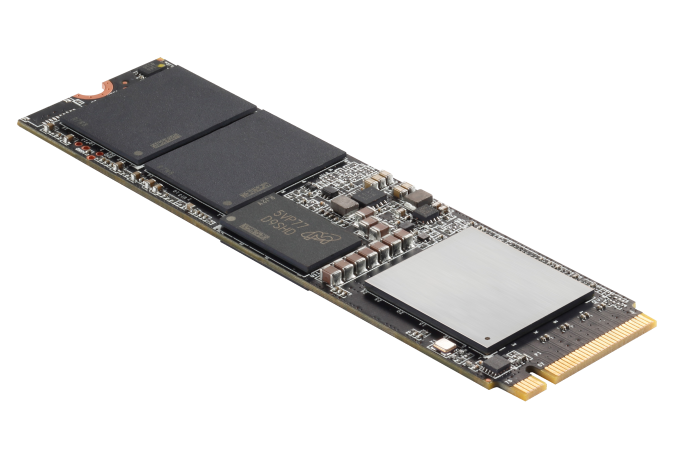Micron Launches 3D NAND Client SSDs
by Billy Tallis on May 31, 2016 11:00 AM EST- Posted in
- SSDs
- Micron
- 3D NAND
- Computex_2016

Today Micron is announcing their first client/OEM SSDs with 3D NAND. First mentioned at an enterprise announcement event in April, the Micron 1100 and 2100 SSDs are part of an aggressive transition strategy that has switched almost all of their flash production capacity over to 3D NAND and left only enough 16nm output to fulfill their obligations for existing product lines.
The Micron 1100 is a mainstream client SATA drive in M.2 and 2.5" form factors. It uses Marvell's 88SS1074 controller and Micron's 384Gb 32-layer TLC NAND and is the replacement for the Micron M600, which used their 16nm MLC. Micron's 3D TLC is unusual in having a capacity (48GB) that is not a power of two, but the 1100 retains the traditional drive capacity points of 256GB, 512GB and 1TB, and extends the line to 2TB. Micron hasn't yet disclosed how many dies and how much overprovisioning each model will have, but the 256GB model will probably include 6 dies giving a raw capacity of 288 GiB.
| Micron 1100 Specifications | |||||
| Capacity | 256GB | 512GB | 1TB | 2TB | |
| Controller | Marvell 88SS1074 | ||||
| NAND | Micron 384Gb 32-layer 3D TLC | ||||
| Form Factors | 2.5" 7mm, M.2 2280 single-sided | 2.5" 7mm | |||
| Sequential Read | 530MB/s | 530MB/s | 530MB/s | 530MB/s | |
| Sequential Write | 500MB/s | 500MB/s | 500MB/s | 500MB/s | |
| 4KB Random Read | 55K IOPS | 92K IOPS | 92K IOPS | 92K IOPS | |
| 4KB Random Write | 83K IOPS | 83K IOPS | 83K IOPS | 83K IOPS | |
| DevSlp Idle Power | 2mW | 2mW | 4mW | 25mW | |
| Encryption | TCG Opal | ||||
| Endurance | 120TB | 240TB | 400TB | 400TB | |
The Micron 1100 has slightly reduced performance and endurance specifications relative to the M600, but it retains the full feature set including TCG Opal encryption, partial power loss protection and SLC caching. The Marvell 88SS1074 was designed with TLC NAND in mind and thus also brings LDPC error correction support.
The Micron 2100 M.2 PCIe NVME will be Micron's first client PCIe SSD and their first PCIe SSD with 3D NAND. Micron has not yet finalized the technical specifications for the 2100, but we do know it will be available in capacities up to 1TB as a double-sided M.2 2280 card.
The Micron 1100 will begin mass production in July, followed by the 2100 by the end of summer.











20 Comments
View All Comments
jjj - Tuesday, May 31, 2016 - link
Short term 3D might have a small price premium so it will be interesting to see how they price these.Chaitanya - Tuesday, May 31, 2016 - link
A little too late to market.bill.rookard - Tuesday, May 31, 2016 - link
Perhaps, but if it has any downward pricing pressure on Samsung, it will help the average consumer.Chaitanya - Wednesday, June 1, 2016 - link
Atleast on 850 EVO series Samsung had brought pricing of their SSDs down to the point where SSDs from other manufacturers aren't just attractive enough.barleyguy - Tuesday, May 31, 2016 - link
The Crucial MX-300, which is essentially the same technology, should be to market much sooner. (Crucial and Micron are the same company.)Ej24 - Tuesday, May 31, 2016 - link
Crucial already drastically undercuts Samsung in the consumer arena. Their MX series offers MLC nand at a price below Samsung (and most others) TLC nand (either 3d or planar). MLC is faster and generally has better endurance. I would expect the consumer version of these to continue the trend. However, I hope crucial still releases a consumer MLC drive. I just don't trust tlc after the 840 Evo fiasco.linster - Tuesday, May 31, 2016 - link
I still haven't figured out if the 840 fiasco was a general TLC issue or a Samsung specific issue.Impulses - Tuesday, May 31, 2016 - link
The 840 was pre-3D, the 850 seem really solid after months on the market, my 2x 1TB have been working alright as has my sister's 840 EVO post update... Did they ever release a fix for the non EVO 840 tho?Impulses - Tuesday, May 31, 2016 - link
Talking about the EVOs obviously. Frankly the 840 issues, while not handled the best way possible, were still not as bad as many of the issues that have plagued every other OEM... And 3D NAND radically changed how TLC is handled anyway.Glaring_Mistake - Tuesday, May 31, 2016 - link
I'd say it is not specific to Samsung but at the same time an SSD using 2D TLC NAND does not have to suffer from read speed issues even at small litographies.For example the 19nm TLC NAND (same litography as 840 EVO) made by SanDisk does not seem to suffer from that issue.
Haven't seen any sign that the 15nm TLC NAND made by SanDisk does either.
However the 16nm TLC NAND by SK Hynix and the 16nm TLC NAND by Micron do.